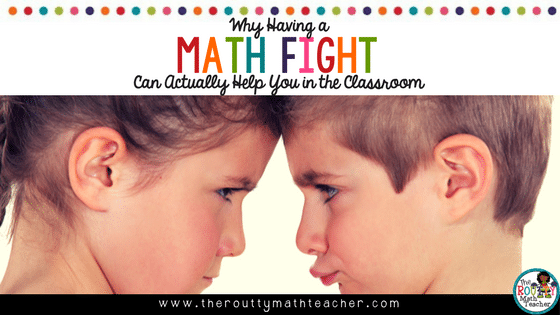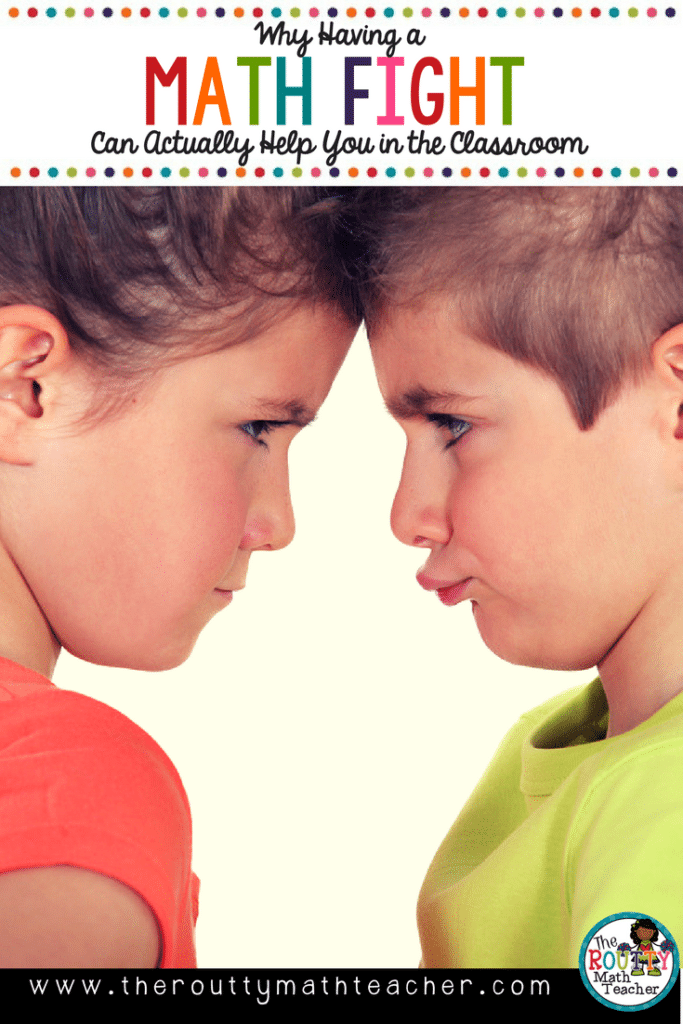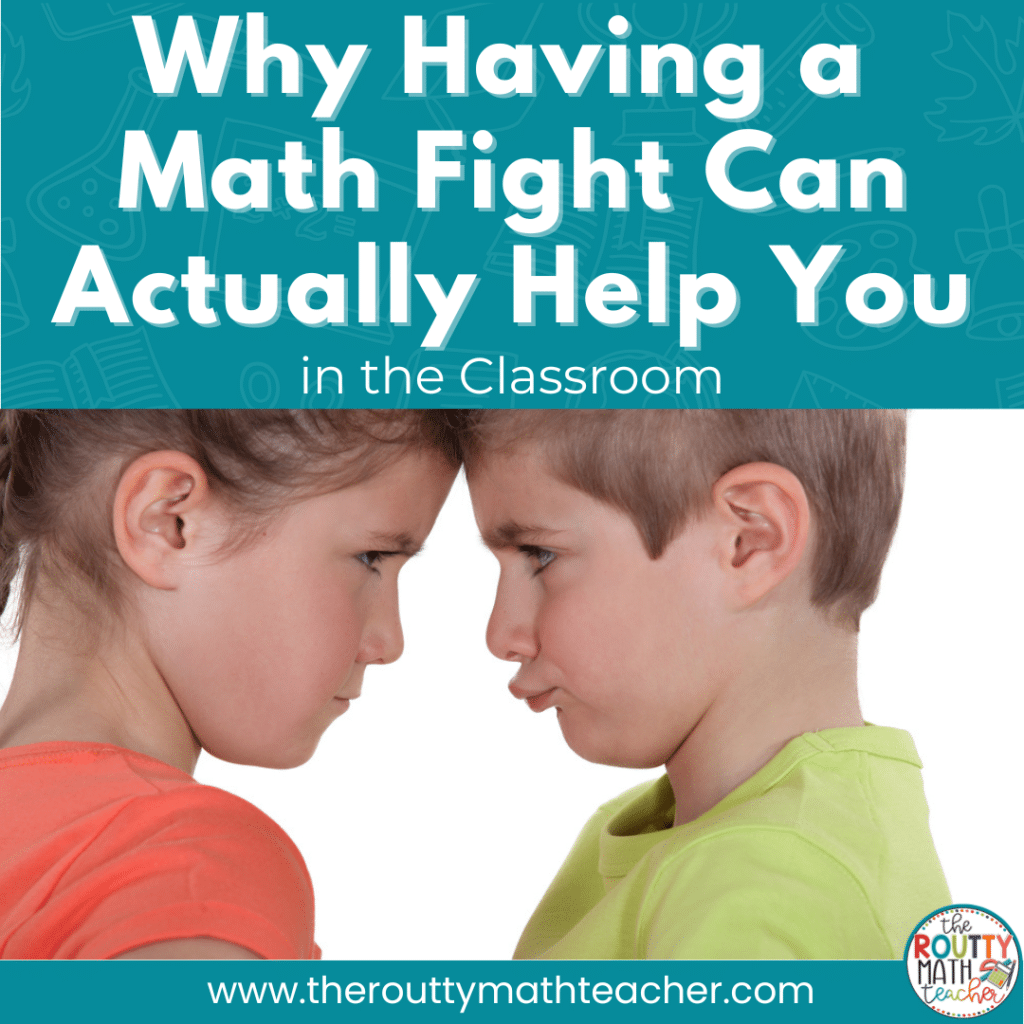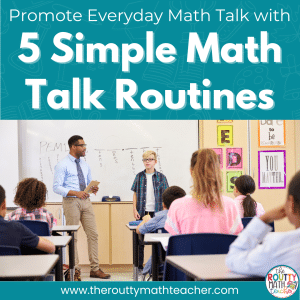
Recently, I participated in a math training where our training facilitator talked about starting a math fight. I’d never heard of a mathematical discussion referred to in this way, but I have to admit, the idea of having a “math fight” excited me. It was even more exciting to think about how the notion of a math fight would enhance student learning. With the idea of a “math fight” in mind, I’m sharing three ways I’ve learned to get a math fight started in the classroom and how to use the fight to help increase student learning.
The idea of using a math fight in the classroom addresses several standards for mathematical practice (from the Common Core State Standards for Math) as students have to first make sense of a problem or situation, possibly using a model to support their work, formulate an opinion, and then construct an argument to express their opinion to others.
- CCSSM MP1: Make sense of problems and preserve in solving them.
- CCSSM MP3: Construct viable arguments and critique the reasoning of others.
- CCSSM MP4: Model with mathematics.
Starting a math fight where students disagree about a math problem or situation provides an opportunity for students to sharpen their communication skills as they listen to the ideas and reasoning of their classmates and defend their own thinking during the discussion. As teachers, we can encourage the discussion and use the disagreement as a springboard to expand student thinking.
The authors of a 2011 article in Teaching Children Mathematics offer three ways to start a math disagreement. In the paragraphs that follow, I offer suggestions from my own years in the classroom for ways to use these strategies to create a mathematical discourse that will enhance the understanding of all students.
1. Force students to choose a side– Providing a task where students are required to choose a side automatically presents a forum for debate. The best way to do this is to select a skill or standard where there are common misconceptions. You can then use the debate to highlight the misconception and encourage discussion surrounding it. Using strategies like, “Who’s Correct?” create instant opportunities for debate because students have to critique a person’s response and then provide an explanation as to why the answer is correct or incorrect. See the image below for an example.

The image above illustrates an opportunity to address a common misconception when comparing fractions and get students communicating mathematically with their peers. You’ll note that both students appear to have the same answer; however, upon closer inspection, we can see that Adam’s thinking is actually incorrect. Both Brandi’s answer and thinking are correct. Forcing students to take a side on this issue will create discussion surrounding the fact that both students gave the correct answer; however, it will reveal a student misconception and provide direction for a follow-up lesson on comparing fractions.
2. Reveal students’ misconceptions– As illustrated above, use of a math fight can reveal student misconceptions surrounding a topic especially when student responses are used to “initiate” the fight. For example, imagine providing students with the problem above and then asking them to respond to the prompt with who ran farther and their reasoning. After reading the students’ responses, select two responses that most represent the class, one correct and one incorrect answer. This will allow you to directly address your own students’ misconceptions and pose them via the math fight. Because students will have to decide which argument to support, more erroneous thinking may be revealed. The beauty, however, comes via the discussion. Having students present their case and “argue” about the right answer and/or reasoning offers a rich opportunity that we may not otherwise achieve during a day-to-day lesson. Even better, listening to the debate as a spectator/referee will provide valuable feedback on areas to highlight or address differently for your next class of students.
3. Recall last year’s disagreements– Another way to initiate a math fight is to consider the misconceptions of previous years as this will provide some direction in how to prepare for misconceptions your current students may have surrounding a topic. In addition, over the years, I have learned that bringing up a misconception by saying, “One of my student’s last year commented that . . . .” provides an opening to discuss the misconception if it does not come up naturally but is something that I want to address. This is a helpful strategy because bringing up the misconception in a non-threatening way allows students to view the situation more objectively as they perceive that the erroneous thinking does not relate to them.
At first, the idea of starting a math fight may seem counterproductive to our goals as a teacher. However, starting a math fight may be just what our students need to better understand the content that we teach. It also provides a fun opportunity to practice communicating mathematically and constructing convincing and sound mathematical arguments.
Freebie Alert! You can grab a few free templates like the one above by clicking here. To use them: 1.) Download the images to your computer. 2.) Insert them into a PowerPoint file. 3.) Add text boxes with your own names and content. Enjoy!
Sound Off! Describe a time when you have used a math fight in the classroom to expand student thinking?
Respond in the comments below.
Reference: Barlow, A. T. and McCrory, M. R. (2011). Three strategies for promoting math disagreements. Teaching Children Mathematics. 17, 530-539.







3 Responses
Is there a way to get a copy of your example? I’ve downloaded your templates. Thank you!!
Hi Ann! You can absolutely have a copy of the example! I uploaded the example to the folder with the templates. You can access it using the same link. Please let me know if you don’t see it. Enjoy!
Hi, my name is Hamisu ibrahim a graduate teacher from bayero university kano Nigeria, I read your blog its very interesting I love it. I also blog on primary education in Nigeria.